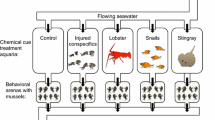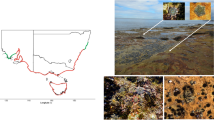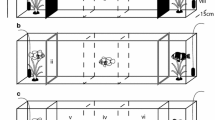Abstract
Chemical cues released by damaged or dead organisms can affect how and where benthic organisms feed. These cues may cause predators to act as opportunistic scavengers in lieu of their normal predatory role. A scavenger, as defined in this study, is an organism that consumes damaged and/or dead organisms. In-situ experiments were performed to determine how the seastar Pycnopodia helianthoides (Brandt) reacts in the presence of chemical cues from one of its prey species, the butter clam Saxidomus giganteus (Deshayes), using both intact and damaged individuals. The results of these experiments suggest that P. helianthoides use their chemosensory abilities to locate damaged/dead prey. The role of current in propagating chemical cues was paramount in this foraging activity. P. helianthoides chose damaged prey over live prey even when live prey was encountered en route to the damaged individual. This study suggests that chemical cues emitted from damaged or dead individuals may cause significant changes in foraging tactics of key predators, thus altering food-web dynamics.



Similar content being viewed by others
References
Beddingfield SD, McClintock JB (1993) Feeding behavior of the seastars Astropecten articulatus (Echinodermata: Asteroidea): an evaluation of energy-efficient foraging in a soft-bottom predator. Mar Biol 115:669–676
Breen PA (1979) Selective feeding of the sunflower star, Pycnopodia helianthoides, in the laboratory. Fisheries and Marine Service. Manuscript Report 1498
Carroll ML (1994) The ecology of a high-latitude rock intertidal community: processes driving population dynamics in Kachemak Bay, Alaska. PhD Thesis, University of Alaska, Fairbanks
Dayton PK, Robilliard GA, Paine RT, Dayton LB (1974) Biological accommodation in the benthic community at McMurdo Sound, Antarctica. Ecol Monogr 44:105–128
Dayton PK, Thrush SF, Agardy MT, Hofman RJ (1995) Environmental effects of marine fishing. Aquat Conserv Mar Freshwater Ecosyst 5:205–232
Delwiche LD, Slaughter SJ (1996) The little SAS book. SAS Institute, N.C.
Duggins DO (1983) Starfish predation and the creation of mosaic patterns in a kelp dominated community. Ecology 58:1218–1236
Flagg PJ, Malouf RE (1983) Experimental plantings of juveniles of the hard clam Mercenaria mercenaria in the waters of Long Island, NY. J Shellfish Res 3:19–27
Greer DL (1961) Feeding behavior and morphology of the digestive system of the seastar Pycnopodia helianthoides (Brandt) Stimpson. MS Thesis, University of Washington, Seattle
Groenewold S, Fonds M (2000) Effects on benthic scavengers of discards and damaged benthos produced by the beam-trawl fishery in the southern North Sea. ICES J Mar Sci 57:1395–1406
Herrlinger TJ (1983) The diet and predator-prey relationships of the seastar Pycnopodia helianthoides from a central California kelp forest. MS Thesis, San Jose State University, Moss Landing
Himmelman JH (1988) Movement of whelks (Buccinum undatum) towards a baited trap. Mar Biol 97:521–531
Hines AH, Whitlatch RB, Thrush SF, Hewitt FE, Cummings VJ, Dayton PK, Legendre P (1997) Nonlinear foraging response of a large marine predator to benthic prey: eagle ray pits and bivalves in a New Zealand sandflat. J Exp Mar Biol Ecol 216:191–210
Kaiser MF, Spencer BE (1996) Behavioral responses of scavengers to beam trawl disturbance. In: Greenstreet SPR, Tasker ML (eds) Aquatic predators and their prey. Blackwell Science, Cambridge, pp 116–123
Lambert P (1981) The seastars of British Columbia. British Columbia Prov Mus Handbook 39
Lapointe V, Sainte-Marie B (1992) Currents, predators, and aggregation of the gastropod Buccinum undatum around bait. Mar Ecol Prog Ser 85:245–257
Lourey MJ, Ryan DAJ, Miller IR (2000) Rates of decline and recovery of coral cover on reefs impacted by, recovering from and unaffected by crown-of-thorns starfish Acanthaster planci: a regional perspective of the Great Barrier Reef. Mar Ecol Prog Ser 196:179–186
MacGinitie GE, MacGinitie N (1949) Natural history of marine animals. McGraw-Hill, New York
Mauzey KP, Birkeland C, Dayton P (1968) Feeding biology of asteroids and escape responses of their prey in the Puget Sound region. Ecology 49:603–619
McConnaughey RA, Mier KL, Dew CB (2000) An examination of chronic trawling effects on soft-bottom benthos of the eastern Bering Sea. ICES J Mar Sci 57:1377–1388
Menge BA (1971) Foraging strategy of a starfish in relation to prey availability and environmental predictability. Ecol Monogr 42:25–48
Mensink BP, Fischer CV, Cadee GC, Fonds M, Ten Hallers-Tjabbes CC, Boon JP (2000) Shell damage and mortality in the common whelk Buccinum undatum caused by beam trawl-fishery. J Sea Res 43:53–64
Miller RJ (1990) Effectiveness of crab and lobster traps. Can J Fish Aquat Sci 47:1228–1251
Moitozoa DJ, Phillips DW (1979) Prey defense, predator preference, and nonrandom diet. The interactions between Pycnopodia helianthoides and two species of sea urchins. Mar Biol 53:299–304
Ninio R, Meekan M, Done T, Sweatman H (2000) Temporal patterns in coral assemblages on the Great Barrier Reef from local to large special scales. Mar Ecol Prog Ser 194:65–74
Paine RT (1974) Intertidal community structure: experimental studies on the relationship between a dominant competitor and its principal predator. Oecologia 15:93–120
Paul AJ, Feder JM (1975) The food of the seastar Pycnopodia helianthoides (Brandt) in Prince William Sound, Alaska. Ophelia 14:15–22
Pearse JH, Hines AH (1987) Long-term population dynamics of sea urchins in a central California kelp forest: rare recruitment and rapid decline. Mar Ecol Prog Ser 39:275–283
Ross DJ, Johnson CR, Hewitt CL (2002) Impact of introduced seastars Asterias amurensis on survivorship of juvenile commercial bivalves Fulvia tenuicostata. Mar Ecol Prog Ser 241:99–112
Shivji M, Parker D, Hartwick B, Smith MJ, Sloan NA (1983) Feeding and distribution study of the sunflower seastar Pycnopodia helianthoides. Pac Sci 37:133–140
Sloan NA (1980) Aspects of the feeding biology of asteroids. Oceanogr Mar Biol Annu Rev 18:57–124
Sloan NA, Campbell AC (1982) Perception of food. In: Jangoux M, Lawrence JM (eds) Echinoderm nutrition. Balkema, Rotterdam, pp 3–23
Valentincic T (1983) Innate and learned responses to external stimuli in Asteroids. In: Jangoux M, Lawrence JM (eds) Echinoderm studies. 1. Balkema, Rotterdam, pp 111–138
Veale LO, Hill AS, Brand AR (2000) An in situ study of predator aggregations of scallop (Pecten maximux) dredge discards using a static time-lapse camera system. J Exp Mar Biol Ecol 255:111–129
Warner GF (1979) Aggregation in echinoderms. In: Larwood G, Rosen BR (eds) Biology and systematics of colonial organisms. Academic, New York, pp 375–396
Wobber DR (1975) Agonism in asteroids. Biol Bull 148:483–496
Zhou S, Shirley TC (1997) Chemoreception and feeding responses of red king crabs to potential bait extracts. Crust Res 26:1–15
Zimmer-Faust RK, Case JF (1982) Odors influencing foraging behavior of the California spiny lobster, Panulirus interruptus, and other decapod crustacea. Mar Behav Physiol I 9:35–58
Author information
Authors and Affiliations
Corresponding author
Additional information
Communicated by J.P. Grassle, New Brunswick
Rights and permissions
About this article
Cite this article
Brewer, R., Konar, B. Chemosensory responses and foraging behavior of the seastar Pycnopodia helianthoides. Marine Biology 147, 789–795 (2005). https://doi.org/10.1007/s00227-005-1608-7
Received:
Accepted:
Published:
Issue Date:
DOI: https://doi.org/10.1007/s00227-005-1608-7




